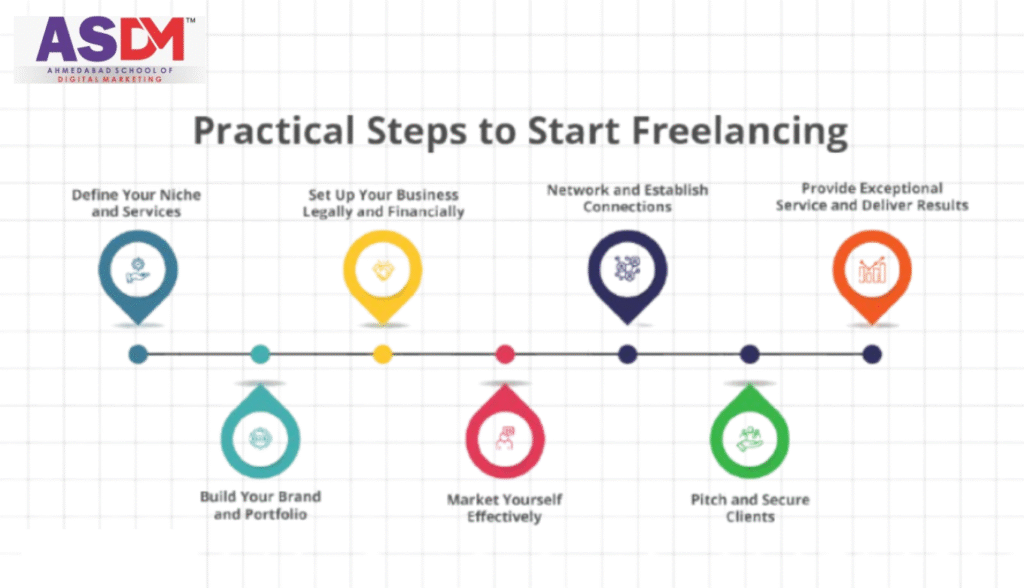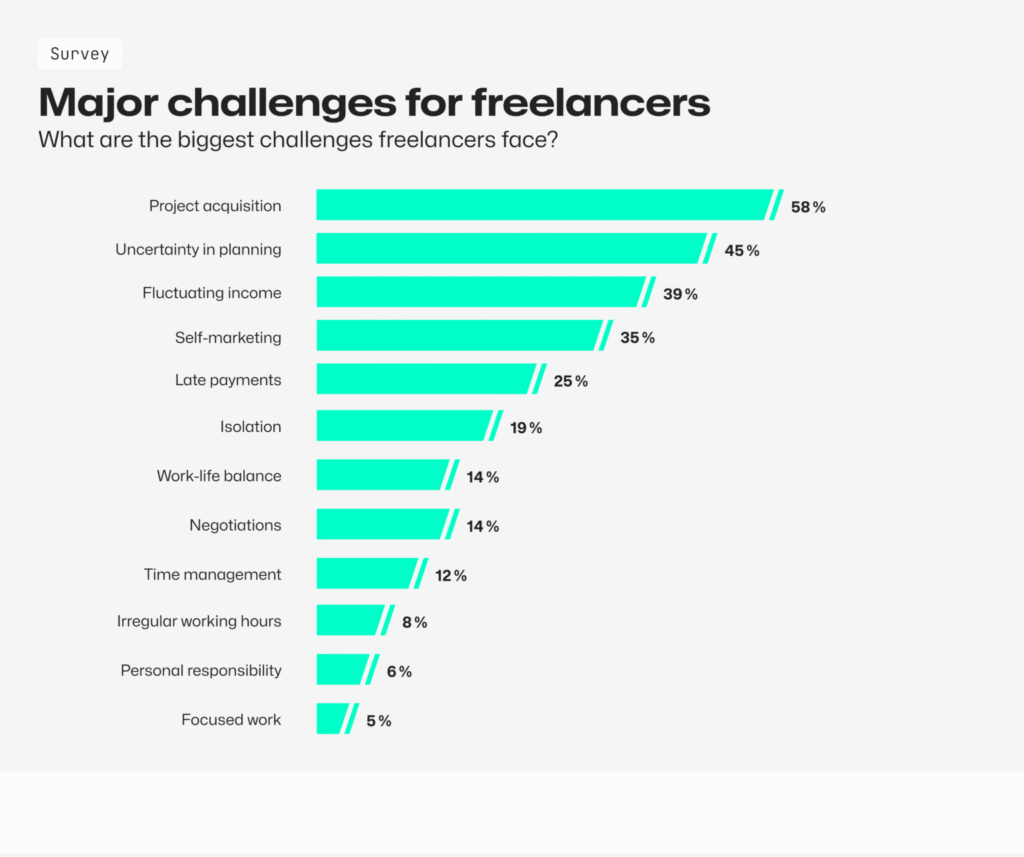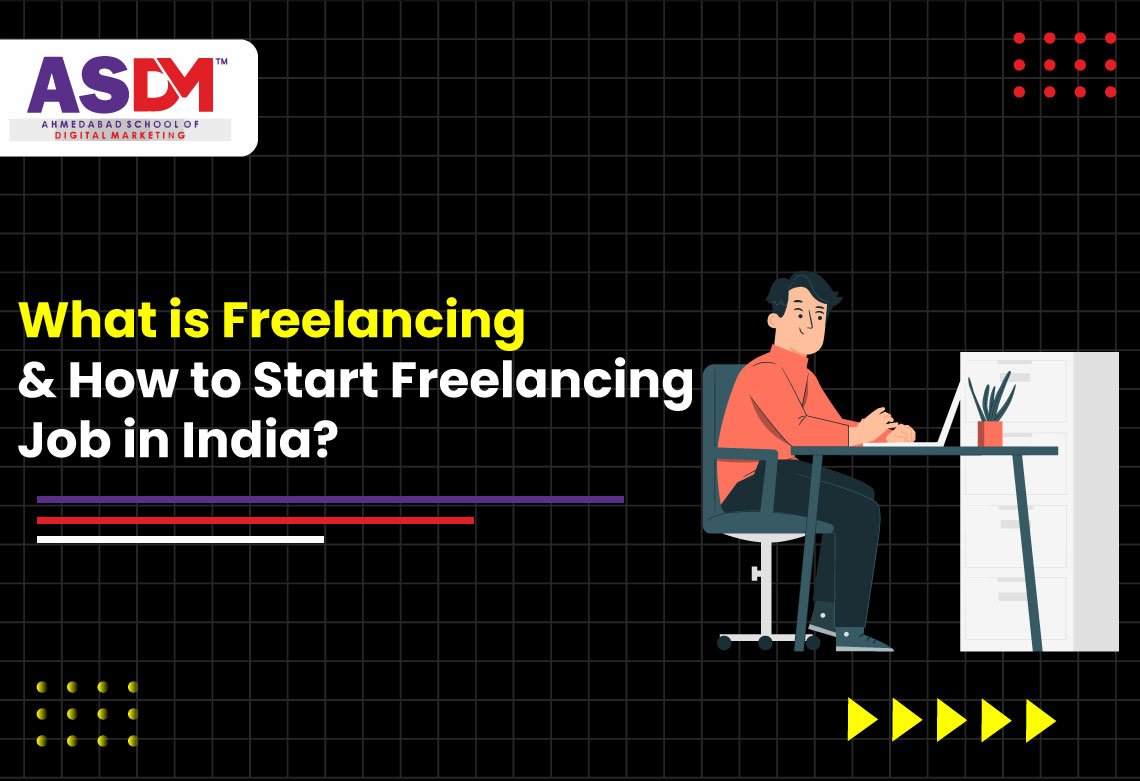Freelancing is a way of working where individuals offer their services to clients or companies on a project or contract basis—rather than being employed full-time. Simply put, freelancers are self-employed professionals who work independently across various industries like writing, design, digital marketing, and software development. Unlike a typical job, freelancers choose who they work with, what projects they take on, and how much they charge.
In the context of freelancing in India, this model has gained massive popularity, especially with the growth of the digital economy and remote work. Whether you are a student looking to earn extra income or a skilled professional seeking work-life balance, freelancing allows you to monetize your talents without being tied down to one employer.
To begin freelancing in India, you first need a valuable skill that is in demand—like digital marketing, graphic design, or content writing. Once you’re confident in your ability, the next step is to create a professional profile on platforms like Fiverr, Upwork, or Freelancer. You showcase your skills, submit proposals to clients, and negotiate terms like deadlines and payments.
Most clients hire freelancers for short-term tasks, ongoing projects, or consulting needs. You work remotely, deliver the agreed work, and get paid—either hourly or on a fixed-price basis. As you build a strong portfolio and gain positive reviews, your reputation and earning potential grow.
While both freelancing and full-time jobs offer income and career growth, they differ significantly in structure and lifestyle. In a full-time job, you have fixed working hours, a stable salary, and benefits like health insurance or paid leave. On the other hand, freelancing offers flexibility—you control your schedule, workload, and earnings.
However, freelancing in India comes with challenges like income instability and no employee benefits. Yet, for those who value independence and have the right skills, freelancing offers a rewarding path that aligns with modern work preferences.
Why is Freelancing Becoming Popular in India?
Freelancing in India is rapidly becoming a preferred career choice among professionals, students, and even homemakers. One of the biggest reasons is the rise of the gig economy, where companies prefer hiring on-demand talent for specific tasks instead of full-time employees. With the increasing adoption of remote work post-pandemic, geographical barriers have blurred, giving Indian freelancers access to both domestic and global clients. Platforms like Upwork, Fiverr, and Freelancer have made it easier than ever to connect with clients, bid on projects, and build a remote career from the comfort of home.
Another driving force behind the popularity of freelancing in India is the surge in demand for digital and creative services. Businesses today rely heavily on digital marketing, graphic design, SEO, content creation, and social media management to grow online—and freelancers are filling that gap with specialized, affordable solutions. This demand has opened up countless freelancing opportunities for individuals equipped with these modern skills.
Moreover, freelancing offers unmatched flexibility and autonomy. Freelancers can choose when, where, and how much they work, making it ideal for people who prefer non-traditional career paths. Whether it’s pursuing passion projects, earning a side income, or building a full-time freelance business, the earning potential in freelancing is significant. Unlike fixed-salary jobs, freelancers can scale their income based on workload, pricing, and client base.
Overall, freelancing in India represents freedom, opportunity, and the future of work. With the right skills and mindset, anyone can carve out a successful freelance career and enjoy both financial and professional independence.
Skills Required to Start a Freelancing Career in 2025
To succeed in freelancing, the most essential requirement is possessing a marketable skill that’s in demand. Among all the popular options available, digital marketing stands out as one of the most profitable and scalable skills. Whether you want to offer services like SEO, social media marketing, content creation, or performance ads, the foundation starts with enrolling in a quality Digital Marketing Course. This course equips you with the practical knowledge and tools needed to offer real value to clients, which is the core of a successful freelancing career.
However, simply watching YouTube videos or free tutorials isn’t enough to become a credible freelancer. It’s important to learn from a trusted digital marketing institute that not only teaches you the latest industry techniques but also focuses on hands-on training and live projects. A reputed institute ensures you build the right skill set, confidence, and professional ethics to handle real client work. This is why investing in a certified Digital Marketing Course from a well-known platform makes all the difference in building long-term credibility and client trust.
Institutes like ASDM (Ahmedabad School of Digital Marketing) go a step further in shaping you into a freelance-ready professional. They provide industry-recognized certifications, internship support, and guidance on how to find clients, pitch your services, and set pricing. Their career mentoring and placement assistance even help students kickstart their freelancing journey right after completing the Digital Marketing Course In Ahmedabad. In today’s competitive freelancing market, having the right skills and proper mentorship is what gives you a winning edge.
How to Start a Freelancing Job in India Step-by-Step

1. Identify Your Skill & Niche
Begin by identifying a skill that’s both in demand and aligns with your interests. Popular freelance skills include graphic designing, content writing, video editing, and especially digital marketing. If you’re starting from scratch, enrolling in a structured Digital Marketing Course can give you practical, job-ready skills that are highly sought-after in today’s online market.
2. Build an Impressive Portfolio
Once you’ve chosen your niche, start building a strong portfolio. This should showcase your best work, real client projects (if available), or sample tasks relevant to your skill. If you’re taking a Digital Marketing Course from a reputed institute, leverage their live project assignments to enhance your portfolio and gain credibility with potential clients.
3. Create Accounts on Freelancing Platforms
Register yourself on popular freelancing websites like Upwork, Fiverr, Freelancer, or PeoplePerHour. Make sure your profile includes a professional photo, service description, keywords, and portfolio samples. A well-optimized profile increases your chances of being noticed by clients.
4. Start Pitching & Get First Clients
Don’t wait for clients to approach you—start bidding and sending personalized proposals for relevant jobs. Mention how your experience, projects, or Digital Marketing Course training make you the right fit. Be clear, concise, and confident in your communication.
5. Set Pricing, Terms & Manage Projects Professionally
Once you start getting work, set clear pricing, deadlines, and revision policies. Use tools like Trello, Notion, or Google Workspace to manage workflow efficiently. Building trust and delivering quality will lead to positive reviews and recurring clients.
Best Freelancing Platforms for Beginners in India
If you’re just starting your freelancing journey and live in India, choosing the right platform is your first step toward success. With the rise of the gig economy, there are now many websites where beginners can find freelance work and grow their careers. Let’s explore the best freelancing platforms for beginners in India.

1. Fiverr
Fiverr is one of the best freelancing platforms for beginners in India because of its easy-to-use interface and zero bidding process. Unlike other platforms, Fiverr lets freelancers create services—called “gigs”—and set their own prices. Whether you’re offering graphic design, digital marketing, writing, or voiceover services, Fiverr allows you to showcase your work creatively.
Beginners benefit from Fiverr because clients come to you after finding your gig in search results. This removes the pressure of constantly pitching or applying for work. The platform also allows you to create multiple gigs, giving you a chance to test what works best. Fiverr’s rating and review system help build credibility over time. Payments are secure, and once you complete an order, you get paid within 14 days (or 7 days if you’re a Level 1 seller).
If you’re just starting out and don’t yet have a large portfolio, Fiverr is a great way to get exposure, experience, and build client relationships. Its global user base also means that even if you’re in India, you can attract clients from around the world, making Fiverr a strong contender among the best freelancing platforms for beginners in India.
2. Upwork
Upwork is another one of the best freelancing platforms for beginners in India. It offers a wide range of job categories including writing, web development, customer service, and more. Beginners can create a profile, list their skills, and apply for jobs directly posted by clients.
What makes Upwork unique is its robust filtering system, allowing freelancers to find jobs that match their exact skills and experience. The platform encourages long-term relationships through its contract system. Beginners might face competition initially, but Upwork offers skill tests and portfolio options to stand out.
The payment system is safe and secure, using an escrow method that ensures freelancers are paid once the client approves the work. There is also a messaging and time-tracking feature built in, making communication and project management easier. Though Upwork charges a service fee, it decreases as you build stronger relationships and earn more from a single client.
For those in India looking to freelance professionally, Upwork is a great way to find reliable clients and steady work. Its structure and tools make it one of the best freelancing platforms for beginners in India.
3. Freelancer.com
Freelancer.com is one of the oldest and most trusted platforms globally, and it continues to be one of the best freelancing platforms for beginners in India. The platform supports a wide variety of projects ranging from tech and design to content writing and marketing.
As a beginner, you can bid on projects and communicate directly with clients to understand their needs. The platform also hosts contests where freelancers can submit work and win projects—a great way to get noticed and build your profile. While competition can be tough, persistence and good-quality submissions can help you stand out.
Freelancer.com offers a milestone payment system to ensure that freelancers are paid safely in stages. It also has a mobile app, real-time chat, and work tracking tools, making the process smooth for both clients and freelancers.
For Indian freelancers just entering the gig world, Freelancer.com is a valuable platform to gain experience and build an online portfolio. Its large user base and variety of projects make it one of the best freelancing platforms for beginners in India.
4. Truelancer
Truelancer is an Indian freelancing platform designed with the local market in mind, which makes it one of the best freelancing platforms for beginners in India. It offers categories like graphic design, web development, data entry, and content writing, with a strong emphasis on affordability and quick hiring.
Beginners appreciate Truelancer for its simple sign-up process and lower competition compared to international platforms. The platform also supports Indian payment options, which makes transactions easier and faster for local users. Freelancers can apply for jobs, build their reputation with reviews, and even get featured on the homepage for added visibility.
Truelancer provides a secure payment system using escrow, and you can communicate directly with clients through the platform. There’s also a section for part-time and full-time remote jobs, offering more flexibility for Indian freelancers.
For those just starting out and looking to gain experience without getting overwhelmed by global competition, Truelancer stands out as one of the best freelancing platforms for beginners in India.
5. Worknhire
Worknhire is another India-based platform that is tailored specifically for Indian freelancers and businesses. It connects freelancers with Indian startups, agencies, and small businesses looking for cost-effective talent. This focus on local connections makes it one of the best freelancing platforms for beginners in India.
The platform supports a range of job categories including IT, design, content writing, and marketing. Freelancers can register easily, browse projects, and submit proposals. Clients on Worknhire usually prefer working with Indian freelancers, which increases your chances of landing projects when starting out.
Worknhire features a rating system, messaging tools, and secure payment processes, allowing new freelancers to grow their reputation and get paid safely. It’s also less saturated than global freelancing platforms, giving newcomers a better shot at securing jobs.
For beginners who want to work with Indian clients, understand the local market, and build a career in freelancing step-by-step, Worknhire is a reliable and one of the best freelancing platforms for beginners in India.
Challenges Freelancers Face and How to Overcome Them

While freelancing offers freedom and flexibility, it comes with its own set of challenges that every beginner must be prepared for. One of the biggest hurdles is inconsistent income. Unlike a salaried job, freelance earnings can vary month to month, depending on how many clients or projects you secure. To create financial stability, freelancers should diversify their client base, save aggressively during high-earning months, and explore recurring work or retainers on a trusted freelancing platform. Building long-term client relationships also helps in generating predictable income over time.
Another common issue is managing multiple clients and overlapping deadlines. Without proper time management, this can lead to stress, burnout, or even missed submissions. The best way to tackle this is to plan your schedule in advance using tools like Trello, Notion, or Google Calendar. Always communicate your availability clearly and don’t overcommit. Many freelancing platform interfaces also have in-built features to track project timelines and milestones, making workflow smoother and more organized.
Freelancers must also learn to handle rejection and difficult clients, especially those who delay payments or ghost after delivery. While disappointing, rejections are a normal part of the freelance journey. Improving your pitch and asking for client feedback can help you grow. As for non-paying clients, always use escrow or milestone-based payment systems offered by reputable freelancing platform sites. These offer protection and recourse if disputes arise. Over time, learning to qualify clients and establishing contracts will minimize risk and ensure you get paid for your hard work. By being strategic, disciplined, and resilient, freelancers can overcome these challenges and thrive in the competitive gig economy.
Legal & Financial Aspects of Freelancing in India
Freelancing in India isn’t just about finding clients and completing projects—it also comes with legal and financial responsibilities. One of the most important things to understand is taxation. Yes, freelancers are required to pay income tax in India based on their total annual earnings. If your income exceeds the basic exemption limit, you must file an income tax return just like salaried individuals. Many freelancers make the mistake of ignoring taxes, which can lead to penalties and notices. Whether you work independently or through a freelancing platform, your earnings are considered taxable income.
In addition to taxes, freelancers must also ensure that they have the right documentation. Having a PAN card is mandatory for filing taxes and financial transactions. If your annual turnover exceeds ₹20 lakhs (₹10 lakhs in some states), you are required to register for GST. While GST may not be essential for everyone starting out, having a dedicated bank account for freelancing income is highly recommended for smooth transactions and recordkeeping. It helps separate personal and professional finances, which is important for long-term financial management.
Equally vital is creating invoices and tracking payments. Freelancers should issue professional invoices that include tax information, payment terms, and bank details. Many freelancing platform sites offer built-in invoicing tools, but independent freelancers can use software like Zoho Invoice or QuickBooks. Using trusted payment gateways like Razorpay, Payoneer, or Wise helps ensure faster, secure payments from both domestic and international clients. Keeping track of your earnings not only simplifies tax filing but also provides clarity on your business growth. By staying legally compliant and financially organized, freelancers can protect their income and operate more professionally in the long run.
How to Build a Long-Term Freelancing Career
Building a sustainable freelancing career goes beyond just finding one-time projects—it requires long-term planning, continuous learning, and strong client relationships. The most successful freelancers consistently upskill themselves to stay relevant in a rapidly evolving digital world. Enrolling in online courses and certifications not only sharpens your technical knowledge but also boosts your credibility in the eyes of clients. Whether it’s upgrading your digital marketing skills or learning AI tools, staying updated ensures that you can charge more and deliver high-value results, especially on competitive freelancing platform sites.
Equally important is personal branding. In a crowded marketplace, how you present yourself can set you apart. Build a strong online presence through platforms like LinkedIn, where you can showcase your expertise, publish insights, and connect with potential clients. A well-optimized LinkedIn profile acts as your professional resume and increases visibility. Make sure to align your personal brand with your niche so that clients can instantly understand what services you offer and why you’re the right choice.
Client retention is another pillar of long-term freelancing success. While acquiring new clients is important, nurturing existing relationships often leads to recurring work and referrals. Always deliver quality on time, communicate transparently, and exceed expectations. Many clients prefer to work with freelancers they trust instead of hiring new ones repeatedly. Encourage satisfied clients to leave reviews on your freelancing platform profile or recommend you to others. These testimonials add to your credibility and attract more business.
In short, a thriving freelancing career is built on learning, visibility, and relationship-building. By combining skill development course with strategic branding and strong client service, you create a career that not only survives but grows year after year.
Final Thoughts: Is Freelancing Worth It in 2025 India?
Freelancing in India has transformed from a side hustle into a viable full-time career, and its prospects in 2025 look more promising than ever. With businesses increasingly shifting online and preferring cost-effective, remote talent, the demand for skilled freelancers is only growing. Fields like digital marketing, content creation, and design continue to flourish, creating abundant opportunities across every major freelancing platform. As India’s internet infrastructure improves and the digital economy expands, freelancers can expect a steady rise in project availability, payment standards, and global collaborations.
The next five years will likely witness the rise of niche freelancers who offer specialized expertise and position themselves as micro-agencies. Those who invest in skill development, adapt to technology trends, and maintain a client-first approach will thrive in this competitive landscape. Moreover, platforms are becoming smarter with AI-powered job matching, dispute resolution, and integrated tools that help freelancers manage their careers more efficiently.
If you’re wondering whether to start freelancing as a student or a working professional, the answer is—both can benefit greatly. Students can build portfolios, gain experience, and earn income even before graduation. Freelancing also helps them discover their niche early. For working professionals, freelancing provides an alternate income stream, creative freedom, and a transition path toward self-employment. In both cases, starting small, joining a reliable freelancing platform, and staying consistent is key to long-term success.
In conclusion, freelancing in 2025 is not just a career option—it’s a movement reshaping how India works. Whether you’re starting fresh or switching gears, freelancing offers the freedom, growth, and satisfaction that few traditional jobs can match. With the right mindset and skills, the possibilities are limitless.
FAQs: What is Freelancing & How to Start Freelancing Job in India?
What is freelancing and how does it work?
Freelancing is a form of self-employment where you work independently for different clients instead of being tied to one employer. You offer your services on a project or hourly basis, depending on the agreement. Freelancers choose when and how they work, allowing flexibility and control over their schedule. Clients post jobs online or directly reach out to freelancers based on their skill set. Once hired, you complete the task, submit it, and get paid after approval. Many people in India are turning to freelancing to earn extra income, build a portfolio, or even create a full-time career.
How can I start freelancing in India with no experience?
You can start freelancing in India even without experience by identifying a skill you can offer, such as writing, graphic design, data entry, or social media management. Learn the basics through online courses, create sample work to showcase your ability, and sign up on beginner-friendly platforms like Fiverr or Truelancer. Start small, charge competitive rates, and deliver quality work to build your profile and receive positive reviews. Over time, your experience and client trust will grow. Consistency, patience, and learning from feedback are key for beginners to succeed in freelancing.
Which skills are best for freelancing jobs in India?
Popular and in-demand freelancing skills in India include content writing, graphic design, web development, digital marketing, video editing, SEO, and virtual assistance. These skills can be learned online and applied to various industries. Tech-related skills like app development, UI/UX design, and software testing are also highly valued. When choosing a skill, consider your interests and the time you can dedicate to mastering it. Pick a niche where demand is high and competition is manageable. This will help you stand out and find freelancing jobs more easily in India.
Do I need a GST number or business license to freelance in India?
No, you don’t need a GST number or business license to start freelancing in India unless your annual income crosses the GST threshold (₹20 lakhs for service providers). However, it’s a good idea to maintain proper records of your earnings and pay income tax based on your total income. Freelancing is treated as self-employment under Indian law. As you grow, registering as a sole proprietorship or obtaining a GST number may help in building credibility and working with higher-value clients, especially if they ask for invoices with GST details.
How do freelancers get paid in India?
Freelancers in India usually receive payments through PayPal, Wise (formerly TransferWise), Payoneer, or direct bank transfers. Most freelancing platforms offer secure payment gateways and escrow systems, which ensure you get paid once your work is accepted. It’s essential to link your Indian bank account or digital wallet to the platform to receive payments smoothly. Always discuss payment terms before starting a project, and avoid working with clients who refuse secure payment options. As you grow, setting clear payment policies and maintaining proper financial tracking will help you stay organized.
Which freelancing website is best for beginners in India?
Some of the best freelancing platforms for beginners in India include Fiverr, Truelancer, Worknhire, and Freelancer.com. These platforms are user-friendly and have low entry barriers, making them ideal for those new to freelancing. Fiverr allows you to list your services, while platforms like Freelancer.com and Truelancer offer bidding options for projects. Worknhire focuses on Indian clients and offers easy communication and payment. Choose a platform based on your skill, comfort with bidding or creating gigs, and the type of clients you want to work with.
Can students in India start freelancing while studying?
Yes, students in India can definitely start freelancing while studying. In fact, freelancing is a great way for students to earn income, gain real-world experience, and build a strong portfolio. Many students start with writing, graphic design, social media management, or virtual assistant roles. These jobs offer flexible timings that can fit around class schedules. Freelancing also helps students improve their communication, time management, and project skills. Starting early gives them a head start in their career and increases employability after graduation.
How do I build a freelancing portfolio with no client work?
If you’re just starting out, you can create a freelancing portfolio by building sample projects. For example, if you’re a writer, create blog posts on topics you enjoy. If you’re a designer, make logos or social media graphics for imaginary brands. These samples help clients understand your style and skills. You can also volunteer or do small paid gigs for friends, NGOs, or startups in exchange for testimonials. Share your portfolio on platforms like Behance, LinkedIn, or even a simple Google Drive folder. A solid portfolio builds trust with potential clients.
Is freelancing a stable career in India?
Freelancing can be a stable and rewarding career in India if approached with dedication and planning. Initially, income may be inconsistent, but with time, as you gain clients and experience, it can become reliable. Many professionals choose freelancing for its flexibility, freedom, and income potential. It also allows you to work on diverse projects and grow multiple income streams. However, it requires self-discipline, strong time management, and the ability to adapt to changing market trends. Continuous learning and building long-term client relationships are key to maintaining stability.
What are common mistakes to avoid when starting freelancing?
Common mistakes beginners make include underpricing services, not clarifying project scope, poor communication, and skipping contracts. Many new freelancers also rush into projects without understanding the client’s needs, which leads to revisions or disputes. Another mistake is ignoring feedback or failing to meet deadlines. It’s important to treat freelancing professionally: set clear expectations, create detailed proposals, and always maintain a client-first attitude. Also, don’t rely on just one platform or client—build multiple income sources. Learning from early mistakes and improving consistently is the best way to grow your freelancing career in India.

